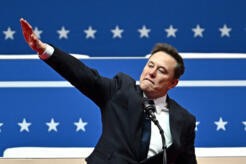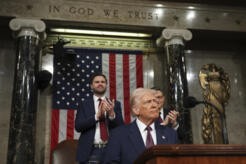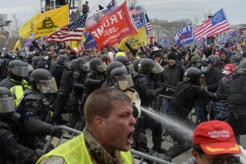Why Do People Compare Trump To Hitler? This is a question that echoes through modern political discourse, sparking intense debate and scrutiny. COMPARE.EDU.VN dives deep into the reasons behind these comparisons, examining historical parallels and potential dangers while providing accessible information. Understand the concerns driving these discussions and find objective insights.
1. Introduction: Understanding the Comparisons
The comparison of Donald Trump to Adolf Hitler is a contentious subject that elicits strong reactions. However, understanding the reasons behind these analogies requires a careful examination of historical context, political rhetoric, and societal concerns. It’s crucial to approach this comparison with nuance, recognizing both the similarities and the vast differences between the two figures. As political climates shift, so does the relevance of understanding historical echoes.
2. Historical Context: The Rise of Authoritarianism
To understand why people make the comparison, it’s crucial to examine the historical context in which Hitler rose to power. Several factors contributed to his ascent, including:
- Economic instability: The aftermath of World War I left Germany in a state of economic turmoil, with hyperinflation and widespread unemployment. This created fertile ground for extremist ideologies that promised solutions.
- Political polarization: German society was deeply divided, with various political factions vying for power. This polarization paralyzed the government and created an environment of instability.
- Scapegoating: Hitler and the Nazi party scapegoated Jews and other minority groups, blaming them for Germany’s problems. This created a sense of unity among their followers and diverted attention from the regime’s failures.
- Propaganda and manipulation: The Nazi regime effectively used propaganda to control public opinion and create a cult of personality around Hitler. They manipulated information and used emotional appeals to gain support.
Understanding these factors is crucial when analyzing current political trends and making historical comparisons.
3. The Rhetoric and Policies: Identifying Parallels
Several aspects of Donald Trump’s rhetoric and policies have drawn comparisons to Hitler and the Nazi regime. These include:
- Nationalism and xenophobia: Both Trump and Hitler employed nationalist rhetoric, emphasizing the importance of national identity and portraying immigrants and minorities as threats. Trump’s calls for building a wall on the Mexican border and his travel ban targeting Muslim-majority countries echo Hitler’s anti-Semitic policies and his emphasis on racial purity.
- Attacks on the media: Both Trump and Hitler frequently attacked the media, accusing them of spreading “fake news” and being enemies of the people. Hitler’s regime controlled the media through censorship and propaganda, while Trump has used social media and rallies to bypass traditional media outlets and communicate directly with his supporters.
- Cult of personality: Both Trump and Hitler cultivated a cult of personality, presenting themselves as strong leaders who could solve their nation’s problems. They used rallies, speeches, and propaganda to build a loyal following and demonize their opponents.
- Use of violence and intimidation: Both Trump and Hitler have been accused of inciting violence and intimidation against their political opponents. Trump’s rhetoric at rallies has been linked to instances of violence against protesters, while Hitler’s regime used violence and intimidation to silence dissent and suppress opposition.
Examining these parallels provides insight into the concerns driving the Trump-Hitler comparisons.
4. Concerns About Authoritarianism: Democracy Under Threat
The comparisons between Trump and Hitler raise concerns about the potential for authoritarianism in the United States. Historians and political scientists warn that democracies can be vulnerable to authoritarian leaders who exploit divisions and undermine democratic institutions.
- Erosion of democratic norms: Trump’s challenges to the legitimacy of elections, his attacks on the judiciary, and his disregard for established norms and traditions have raised concerns about the erosion of democratic institutions.
- Suppression of dissent: Trump’s attacks on the media, his efforts to silence critics, and his use of government power to punish political opponents have been seen as attempts to suppress dissent and consolidate power.
- Rise of extremism: Trump’s rhetoric has emboldened extremist groups and individuals, creating a climate of fear and division. The rise of white nationalism and other forms of extremism poses a threat to democracy and social cohesion.
These concerns underscore the importance of vigilance in protecting democratic values and institutions.
5. Counterarguments and Nuances: Distinguishing Differences
While there are similarities between Trump and Hitler, it’s important to acknowledge the significant differences between them and the historical contexts in which they operated.
- Ideology: Hitler was driven by a clear and coherent ideology of racial supremacy and expansionism, while Trump’s political beliefs are more pragmatic and transactional.
- Political system: The United States has a strong system of checks and balances and a tradition of democratic governance, while Germany in the 1930s was a fragile democracy with a history of authoritarianism.
- Social context: American society is more diverse and pluralistic than German society in the 1930s, making it more difficult for a leader to consolidate power and impose an authoritarian regime.
Recognizing these differences is crucial to avoid simplistic and misleading comparisons.
6. The Danger of Trivialization: Why Comparisons Matter
The comparison of Trump to Hitler can be seen as trivializing the Holocaust and the horrors of the Nazi regime. Some argue that such comparisons are insensitive and disrespectful to the victims of Nazi persecution.
However, others argue that these comparisons are necessary to raise awareness of the dangers of authoritarianism and to prevent history from repeating itself. They believe that it’s important to learn from the past and to be vigilant in identifying and confronting threats to democracy.
The debate over the appropriateness of these comparisons highlights the complex and sensitive nature of historical analysis and political discourse.
7. Expert Opinions: Historians Weigh In
Historians offer varying perspectives on the comparisons between Trump and Hitler. Some historians caution against drawing direct parallels, emphasizing the differences between the two figures and the historical contexts in which they operated.
Other historians argue that there are valid reasons to be concerned about the rise of authoritarianism and that it’s important to learn from the past. They point to similarities in rhetoric, policies, and tactics as evidence of potential dangers.
- Peter Hayes, professor emeritus at Northwestern University, notes that Trump has not targeted a distinct group as the root of all evil to be singled out potentially for murder, but he has multiplied attacks on the ‘enemies within’ who must be removed from the body politic.
- Christopher Browning, professor emeritus at the University of North Carolina, takes a more nuanced view, suggesting Trump’s image of America’s past greatness aligns more with the late 19th century imperial mentality than something akin to Hitler’s Lebensraum.
- Paul Lerner, professor of history at the University of Southern California, observes parallels between Trumpism and the authoritarian rulers of the 1930s and 1940s, particularly in the use of innuendo and the contempt for expert knowledge.
- Anne Berg, professor of history at the University of Pennsylvania, notes that Trump’s attack on the media is actually an attack on truth, fact and objectivity itself.
These differing opinions highlight the complexity of the issue and the importance of considering multiple perspectives.
8. The Role of Media: Amplifying the Debate
The media plays a significant role in shaping public perception of the comparisons between Trump and Hitler. Media outlets often report on these comparisons, amplifying the debate and bringing it to a wider audience.
Some media outlets have been criticized for sensationalizing the comparisons, while others have been praised for providing thoughtful and nuanced analysis. The media’s coverage of this issue reflects the broader political and social divisions in society.
9. Public Opinion: How People Perceive the Comparisons
Public opinion on the comparisons between Trump and Hitler varies widely, depending on political affiliation, ideology, and personal experiences.
Some people strongly agree with the comparisons, seeing Trump as a dangerous authoritarian figure who poses a threat to democracy. Others strongly disagree, viewing the comparisons as unfair and inaccurate.
Understanding public opinion on this issue is crucial for navigating the complex and often polarized political landscape.
10. Global Perspective: International Reactions
The comparisons between Trump and Hitler have resonated internationally, with many foreign leaders and commentators expressing concern about the direction of American politics.
Some foreign observers see parallels between Trump’s policies and the rise of authoritarianism in other countries. They worry about the impact of American politics on global democracy and international relations.
11. The Impact on Political Discourse: Polarization and Division
The comparisons between Trump and Hitler have contributed to the increasing polarization and division in American society. This issue has become a flashpoint in the culture wars, with both sides digging in their heels and refusing to engage in constructive dialogue.
The use of such comparisons can be seen as inflammatory and counterproductive, further exacerbating political tensions.
12. The Future of Democracy: Lessons Learned
The comparisons between Trump and Hitler raise important questions about the future of democracy. What lessons can we learn from the past to prevent the rise of authoritarianism? How can we protect democratic institutions and values in an era of political polarization and social division?
Addressing these questions requires a commitment to critical thinking, open dialogue, and civic engagement.
13. Case Studies: Specific Policies and Actions
To further analyze the comparisons, let’s examine specific policies and actions:
| Policy/Action | Trump | Hitler | Comparison Points |
|---|---|---|---|
| Immigration Policies | Travel ban targeting Muslim-majority countries, family separations at the border. | Nuremberg Laws targeting Jews, restrictions on Jewish immigration. | Targeting specific groups, creating fear and division, discriminatory policies. |
| Media Relations | Frequent attacks on “fake news,” labeling media as “enemies of the people.” | Control of media through propaganda, censorship, and intimidation. | Undermining trust in institutions, controlling information, suppressing dissent. |
| Use of Nationalism | “America First” rhetoric, emphasizing national identity and economic protectionism. | Emphasis on Aryan supremacy, expansionist foreign policy, promoting nationalistic fervor. | Xenophobia, protectionism, prioritizing national interests above international cooperation. |
| Treatment of Political Opponents | Personal attacks, threats of investigation, undermining legitimacy. | Suppression of political opposition, imprisonment, and execution. | Silencing dissent, abusing power, creating a climate of fear. |
| Economic Policies | Tax cuts for the wealthy, deregulation, trade wars. | Rearmament, infrastructure projects, economic policies benefiting the Nazi regime. | Prioritizing specific economic interests, consolidating power, using economic means for political ends. |




This table allows for a more detailed understanding of specific comparisons and their potential implications.
14. Visual Rhetoric: Gestures and Imagery
Beyond words and policies, visual rhetoric plays a key role in shaping perceptions. Consider the use of gestures, symbols, and imagery:
- Gestures: The article mentions Elon Musk’s raised right-arm gesture at a Trump rally, which some historians likened to a Nazi salute. This visual cue immediately evokes associations with Nazi Germany.
- Rallies and Parades: Both Trump and Hitler used rallies and parades to project power and build a following. The visual spectacle of large crowds chanting slogans and displaying symbols of support can be a powerful tool for propaganda.
- Symbolism: The use of specific symbols, such as flags, emblems, and slogans, can also evoke strong emotions and associations.
Understanding the role of visual rhetoric is crucial for interpreting political messages and understanding how they can be used to influence public opinion.
15. The Power of Language: Euphemisms and Dog Whistles
The language used by political leaders can be subtle yet powerful. Euphemisms and dog whistles can be used to communicate coded messages to specific groups while avoiding direct condemnation.
- Euphemisms: Using mild or indirect terms to describe something unpleasant or offensive. For example, the term “economic nationalism” can be used to mask protectionist policies that harm international trade.
- Dog Whistles: Using coded language that is understood by a specific group but not by others. For example, the term “urban crime” can be used to appeal to racial prejudices without explicitly mentioning race.
Being aware of these linguistic techniques is crucial for understanding the underlying messages being communicated by political leaders.
16. The Psychology of Followers: Why People Support Authoritarian Leaders
Understanding the psychology of followers is crucial for understanding the appeal of authoritarian leaders. Several factors can contribute to this phenomenon:
- Fear and anxiety: People may turn to authoritarian leaders in times of uncertainty and insecurity, seeking a strong figure who can provide order and stability.
- Economic hardship: Economic hardship and inequality can create resentment and frustration, making people more receptive to populist messages that promise to address their grievances.
- Social alienation: Social alienation and a sense of belonging can make people more susceptible to extremist ideologies that offer a sense of community and purpose.
- Authoritarian personality: Some people have a natural inclination towards authoritarianism, preferring clear rules, strong leadership, and obedience to authority.
Understanding these psychological factors can help explain why people support authoritarian leaders and how to counter their appeal.
17. The Importance of Education: Combating Misinformation
Education plays a crucial role in combating misinformation and promoting critical thinking. By teaching people how to evaluate information, identify bias, and think critically, we can empower them to resist propaganda and make informed decisions.
- Media Literacy: Teaching people how to analyze media messages and identify sources of bias.
- Historical Education: Teaching people about the history of authoritarianism and the dangers of unchecked power.
- Civic Education: Teaching people about the principles of democracy and the importance of civic engagement.
Investing in education is essential for safeguarding democracy and preventing the rise of authoritarianism.
18. Analyze The Current Political Climate
The political climate is ever changing, so any objective comparison should always keep tabs on the current affairs:
- Political shifts: Take notes of subtle changes within the parties, for example, how some politicians are changing sides, quitting politics, or changing their agenda.
- Social changes: Observe whether the supporters of Trump are increasing or decreasing.
- Cultural acceptance: Study the cultural shifts and assess whether they are in alignment with Trump’s policies or against it.
- Global issues: How the global issues are affecting the country, and how Trump is dealing with those global issue.
19. Call to Action: Protecting Democracy
The comparisons between Trump and Hitler serve as a stark reminder of the fragility of democracy and the importance of vigilance in protecting it.
It’s crucial to:
- Stay informed: Educate yourself about the issues and engage in critical thinking.
- Engage in civic action: Participate in the political process, vote, and advocate for your values.
- Support democratic institutions: Defend the independence of the judiciary, the freedom of the press, and the right to protest.
- Speak out against injustice: Challenge hate speech, discrimination, and any attempt to undermine democratic values.
20. Conclusion: Making Informed Judgments
The decision to compare Trump to Hitler is a complex one. By using COMPARE.EDU.VN, readers are empowered with knowledge, and a balanced overview, to make informed judgments about the state of our political landscape. Through rigorous analysis, diverse perspectives, and historical context, we can navigate the complexities of today’s political landscape and promote a more informed and engaged citizenry.
Navigating the complexities of political discourse requires reliable information. Visit COMPARE.EDU.VN at 333 Comparison Plaza, Choice City, CA 90210, United States, or contact us via Whatsapp at +1 (626) 555-9090 for comprehensive comparisons and resources.
Frequently Asked Questions (FAQs)
- Is it appropriate to compare Donald Trump to Adolf Hitler?
- The comparison is controversial and complex. Some argue it trivializes the Holocaust, while others believe it’s a necessary warning about authoritarianism.
- What are the main similarities between Trump and Hitler?
- Similarities include nationalist rhetoric, attacks on the media, cultivation of a cult of personality, and the use of violence and intimidation.
- What are the main differences between Trump and Hitler?
- Differences include ideology, political system, and social context. Hitler was driven by racial supremacy, while Trump’s beliefs are more pragmatic.
- Does the comparison imply that Trump is literally another Hitler?
- No, the comparison is not meant to imply that Trump is literally another Hitler. It’s meant to raise concerns about authoritarian tendencies and potential threats to democracy.
- How does the media influence the comparison?
- The media amplifies the debate, shapes public perception, and can either sensationalize or provide nuanced analysis.
- What is the international perspective on the comparison?
- Many foreign leaders and commentators express concern about the direction of American politics and see parallels with the rise of authoritarianism in other countries.
- How does the comparison affect political discourse?
- The comparison contributes to increasing polarization and division in American society.
- What can be done to protect democracy from potential threats?
- Stay informed, engage in civic action, support democratic institutions, and speak out against injustice.
- Why do people support authoritarian leaders?
- Factors include fear and anxiety, economic hardship, social alienation, and an authoritarian personality.
- Where can I find more unbiased comparisons of political figures and policies?
- Visit compare.edu.vn for comprehensive and objective analysis of political issues.
